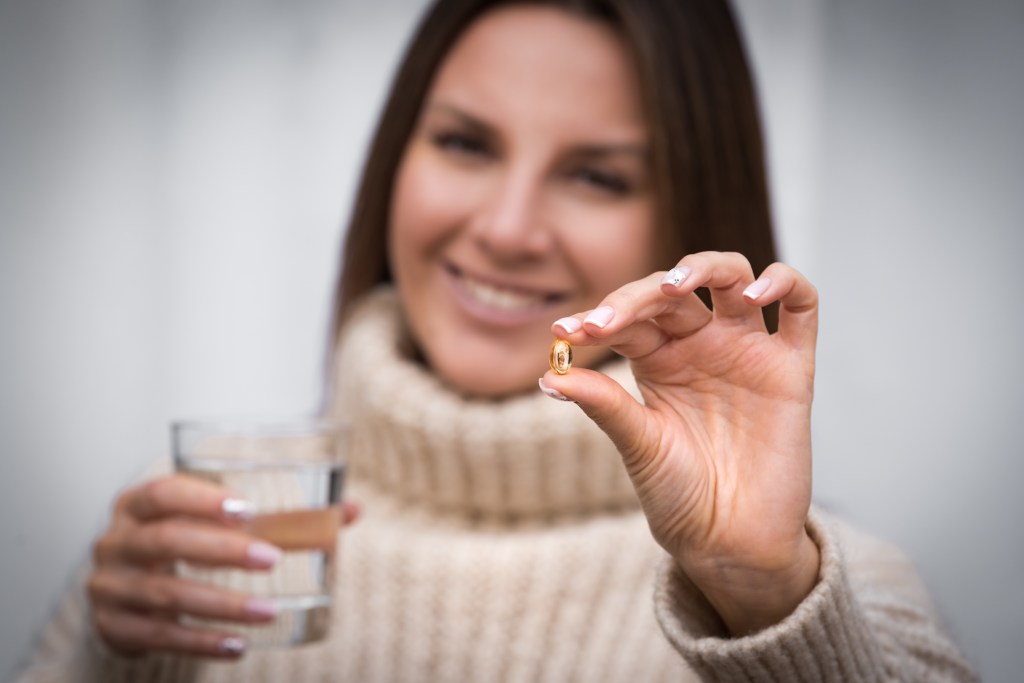At a glance
High-dose vitamin D3 supplementation can help support healthy vitamin D levels, particularly for individuals with limited sunlight exposure or those who have difficulty absorbing nutrients. Maintaining adequate vitamin D supports bone integrity, immune defenses, cardiovascular functions, and mood regulation, making it a crucial nutrient for overall well-being.
While vitamin D supplements are among the most popular dietary supplements, individual needs vary, and many people may not take enough vitamin D3 to maintain healthy levels.
Discover the potential benefits of taking 5000 IU of vitamin D3 daily and find out why it’s crucial to always combine vitamin D3 with vitamin K2.
What is vitamin D3?
Vitamin D3, also known as the sunshine vitamin, is produced when the skin is exposed to ultraviolet B (UVB) rays in sunlight.
UVB light exposure triggers a chain of complex biochemical reactions that convert pre-vitamin D into active vitamin D3.
“The body stores vitamin D3 in the liver and fat cells, which serve as a reservoir that the body can draw upon to compensate for short periods without sunlight exposure,” explains Dr. Berg. “However, prolonged lack of UVB radiation can deplete body stores and result in vitamin D insufficiency.”
The rate of vitamin D3 production can vary significantly from person to person and depends on many factors.
Older people and individuals with darker skin pigmentation may not generate adequate amounts of vitamin D3 despite plenty of sun exposure. This explains why older adults and those with darker skin tones are at increased risk of vitamin D deficiency.
While some foods naturally contain vitamin D3, dietary sources, including fatty fish, egg yolks, and beef liver, typically don’t offer enough vitamin D to maintain healthy levels.
Watch the video below to learn how much vitamin D you may need to maintain healthy levels.
Signs of vitamin D deficiency
Vitamin D regulates various physiological processes, which explains why a lack of adequate vitamin D3 can result in a wide range of symptoms.
Here are common signs of vitamin D deficiency:
- Getting sick more often than usual
- Unexplained and persistent tiredness
- General body discomfort or soreness
- Achy joints
- Hair that sheds more than normal
- Skin changes or breakouts
- Changes in mood

How much vitamin D3 do you need?
While vitamin D3 supplements have been found effective at raising and maintaining healthy vitamin D levels, current intake recommendations are conflicting.
A fact sheet published by the National Institutes of Health (NIH) suggests a daily vitamin D dose of 600 IU.
In contrast, recommendations published by the American Academy of Family Physicians advocate 1000 IU of vitamin D per day for adults, while a study published in Nutrients advises a higher intake of 2000 IU daily.
So, how much vitamin D3 should you be taking?
“Your appropriate vitamin D3 dosage should always be guided by your blood concentrations of 25-hydroxyvitamin D, a blood marker that reflects your body’s overall vitamin D stores,” explains Dr. Berg.
Evidence published in Nutrients suggests that 25-hydroxyvitamin D concentrations of 40 ng/mL (100 nmol/L) or above indicate an optimal vitamin D status and that 600 IU of vitamin D may not be enough to raise vitamin D levels significantly in most individuals.
This aligns with research published in StatPearls reporting that many adults require between 5000 and 10,000 IU of vitamin D3 daily to correct a deficiency and maintain optimal vitamin D levels.
If you are considering taking vitamin D to promote general health, it’s recommended that you consult a healthcare provider and regularly perform vitamin D testing, which helps determine your appropriate vitamin D3 dosage.

Benefits of high-dose vitamin D3 (5000 IU or more)
In some instances, healthcare professionals recommend high-dose vitamin D3 supplementation of 5000 IU or more daily in combination with adequate sunlight exposure and regular intake of vitamin D-rich foods for individuals with a deficiency.
In addition, people with specific health problems, including those with poor nutrient absorption due to digestive disorders such as celiac disease or inflammatory bowel disease (IBD), may not effectively absorb dietary vitamin D and benefit from additional nutritional support.
A study published in Nutrients highlights the potential benefits of high-dose vitamin D3 supplementation in supporting strong immune defenses and recovery and reports no indication of toxicity or other adverse effects.

Risks of high-dose vitamin D3
While vitamin D3 is generally considered safe, it’s a fat-soluble vitamin that can accumulate in the body, and taking too much vitamin D for long periods can have toxic effects.
Excessive amounts of vitamin D supplementation, especially when taken by an individual with optimal vitamin D levels, can lead to vitamin D toxicity, characterized by 25-hydroxyvitamin D blood levels greater than 100 ng/mL (250 nmol/L).
Common symptoms of vitamin D toxicity include:
- Nausea and vomiting
- Gastrointestinal issues
- Unexplained weight loss
- Confusion
- Kidney stones
- Elevated blood calcium levels
To avoid the risk of vitamin D toxicity, it’s recommended to take vitamin D under the supervision of a doctor and perform regular blood tests to adjust your vitamin D3 dosage accordingly.
In addition, it’s important to note that individuals with a medical history of sarcoidosis, primary hyperparathyroidism, or certain cancers are more likely to experience vitamin D-related side effects and shouldn’t take vitamin D without consulting a healthcare professional.

Why take vitamin D3 with vitamin K2
Combining vitamin D3 and K2 is an excellent strategy to support the body’s calcium balance.
While vitamin D3 stimulates intestinal calcium absorption, vitamin K2 plays a role in activating proteins that bind calcium in the blood and deposit it into bone and teeth.
This supports balanced calcium levels in the blood and body tissues, which is crucial for maintaining circulatory functions, cardiovascular wellness, and bone health.
The amount of vitamin K2 to take alongside vitamin D3 can vary based on your D3 intake. A widely recommended vitamin D3 to K2 ratio is 1000:10, meaning you should aim for 10 mcg of vitamin K2 per 1000 IU of vitamin D3.

Four reasons to take vitamin D3
Vitamin D3 is involved in regulating various physiological functions, including calcium balance, immune system activity, nerve signal transmission, and neurotransmitter production.
In fact, vitamin D appears so critical for human health that many scientists suggest it should be classified as a hormone to emphasize the need to maintain optimal levels.
Here are four reasons to maintain optimal vitamin D levels.
1. Supports cardiovascular health
Maintaining adequate vitamin D levels supports blood pressure control, which is associated with healthy circulatory function and balanced blood vessel activity.
Vitamin D is also believed to help regulate how blood vessels function and respond, which can play a role in supporting vascular health.
According to a study published in Nutrients, “Vitamin D receptors (VDRs) are expressed in vascular smooth muscle and endothelial cells, and cardiomyocytes, indicating that vitamin D may influence cardiovascular health.”
2. Promotes healthy bones
Vitamin D aids in the intestinal absorption of calcium, an essential mineral needed for bone metabolism, and supporting optimal vitamin D3 and vitamin K2 status can help support skeletal health and balanced calcium levels in the body.
Promoting bone integrity and skeletal functions plays a vital role in maintaining overall structural balance, mobility, and physical resilience, especially as the body ages.

3. Strengthens immune defenses
Vitamin D3 may play a role in influencing the activity of white blood cells, which are critical for initiating and maintaining the body’s natural defense processes against infections and disease.
It’s also thought that vitamin D helps regulate how immune cells communicate, contributing to a balanced and coordinated immune and inflammatory response.
4. Supports mental health
Low vitamin D levels have been associated with changes in mood, especially during the winter months when sunlight is limited.
This phenomenon has been linked to vitamin D’s involvement in the production of serotonin, a key neurotransmitter that plays a role in emotional balance, mood regulation, and general mental well-being.
Key takeaways
- Maintaining adequate vitamin D levels supports immune defenses, bone integrity, cardiovascular wellness, and mood balance.
- High-dose vitamin D3 supplementation may be needed to restore and maintain healthy vitamin D levels in some individuals.
- Older adults, individuals with darker skin tones, or those with poor nutrient absorption may require higher doses of vitamin D.
- High doses of vitamin D3 should be taken under medical supervision and always combined with vitamin K2 to support calcium balance.
FAQ
1. How much vitamin D3 do I need?
How much vitamin D3 you need depends on your vitamin D levels, age, skin tone, and health status.
Some individuals are able to maintain adequate vitamin D levels with a daily intake of 600 IU, while others may require 5000 IU or more to reach 25-hydroxyvitamin D concentrations of 40 ng/mL (100 nmol/L) or higher.
2. Can I take 5000 IU of vitamin D3 every day?
Yes, taking 5000 IU of vitamin D3 is generally considered safe and well-tolerated by most healthy adults.
However, it’s important to consult with a healthcare provider before using high-dose supplements to determine the appropriate dosage and reduce the risk of adverse effects.
3. What happens if I take 5000 IU of vitamin D3 every day?
Some individuals may benefit from taking 5000 IU of vitamin D3 daily under medical supervision to correct a vitamin D deficiency and maintain healthy vitamin D levels.
Optimal vitamin D status has been found to promote bone health, support strong immune defenses, and may aid balanced mood regulation.
4. Is 5000 IU too high for vitamin D3?
5000 IU of vitamin D3 may be an appropriate dose for individuals with vitamin D deficiency and those at risk of poor vitamin D absorption, including older adults and people with darker skin tones.
Regular blood testing, along with guidance from a medical professional, can help determine the most appropriate dosage based on individual needs and circumstances.
5. How quickly does 5000 IU of vitamin D3 take to work?
The effects of taking 5000 IU of vitamin D3 can vary by individual, but noticeable changes in blood levels may occur within a few weeks.
However, it may take several months to correct a deficiency and reach optimal levels, depending on baseline vitamin D status.
6. What is the best time to take vitamin D3 5000 IU?
Because vitamin D3 is fat-soluble, taking vitamin D with a meal helps improve its absorption, and most people find it convenient to take vitamin D supplements with breakfast or lunch.
7. What are the side effects of 5000 IU of vitamin D3?
While taking 5000 IU of vitamin D3 isn’t linked to side effects, it’s important to note that vitamin D3 enhances intestinal calcium absorption, which can lead to calcium imbalances.
That’s why it’s crucial to take vitamin D3 in combination with vitamin K2, a fat-soluble vitamin that supports blood calcium balance by depositing calcium into bone and teeth.
8. Is it safe to take 5000 IU of vitamin D3?
Taking 5000 IU of vitamin D3 can be an effective strategy to restore and maintain a healthy vitamin D status and is generally considered safe for healthy adults.
Medical supervision and regular blood testing are recommended to monitor vitamin D status and make any necessary adjustments to the dosage.
9. How much vitamin K2 should I take with 5000 IU of vitamin D3?
The best ratio of vitamin D3 and K2 is 1000:10, meaning you should take 50 mcg of vitamin K2 with 5000 IU of vitamin D3.
Sources
- https://ods.od.nih.gov/factsheets/VitaminD-HealthProfessional/
- https://www.aafp.org/pubs/afp/issues/2013/0215/od2.html
- https://www.mdpi.com/2072-6643/16/3/391
- https://www.ncbi.nlm.nih.gov/pmc/articles/PMC3257679/
- https://www.ncbi.nlm.nih.gov/books/NBK532266/
- https://pubmed.ncbi.nlm.nih.gov/34202578/
- https://www.mdpi.com/2072-6643/17/1/115


















